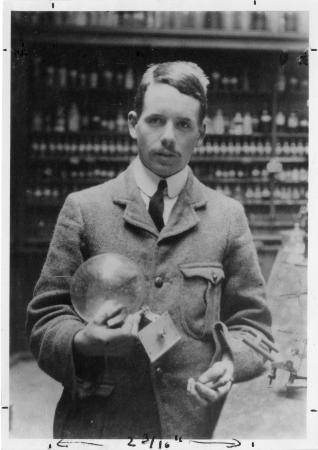English physicist Henry Gwyn Jeffreys Moseley (1887-1915) was engaged in research at the University of Oxford, pioneering in x-ray spectroscopy and becoming a rising star in his field, when World War I began. He volunteered for the Royal Engineers and served as a telecommunications officer. On August 10, 1915, at age 27, Moseley was killed by a sniper during the Battle of Gallipoli.

Over a decade later, Science Service was establishing an archive of photographs of scientists, offering copies for sale and using the images to illustrate its own news articles. The service asked the Cavendish Laboratory for a copy of a Moseley portrait that had been published in Nature magazine. When the copy was finally sent, a laboratory staff member appended a handwritten note to the invoice: “I send photograph of Moseley as requested. This is not for reproduction. I am not in a position to give permission for that. I am not clear if you wanted it for that purpose.”
Watson Davis, the news service’s managing editor, responded that, of course, they wanted to reproduce the photograph. We have “a large list of scientific portraits which we are making available to teachers, museums, newspapers and magazines, a function which we consider important in the public appreciation of science. Certainly, Moseley, whose work has had such vital influence upon physics, should be in this collection.” How, Davis asked, might they obtain the necessary permission?

The process took several months and led eventually to Moseley’s family. In August 1927, they heard from Mosley’s mother, Amabel Gwyn Jeffreys Moseley.
As the daughter of Welsh biologist and conchologist John Gwyn Jeffreys, Amabel Moseley supported efforts to bring science to the public. She wrote that “it is a mistake to suppose that any restriction has been imposed by the Moseley family (that is myself) as to making copies or selling them, and I should feel pleased and proud that his photograph should be included in the list.” Emphasizing her support for publication, she included two other photographs that she regarded as much “better” than the rather formal one from Nature.

On the reverse of each photograph were poignant notations in Amabel’s handwriting: “Henry Gwyn Jeffreys Moseley. Born Nov. 1887. Killed in the Great War at Gallipoli. August 10, 1915.”
Moseley’s death did prompt the British government to establish a policy discouraging prominent scientists from enlisting for combat duty in the armed forces. His contributions to physics and x-ray research have been described widely in the historical literature and were commemorated in 2007 with a historical plaque at Oxford’s Clarendon Laboratory.
Related Resources
- Science Service: Up Close posts, by Marcel Chotkowski LaFollette, The Bigger Picture, Smithsonian Institution Archives
- War Correspondents, by Pamela Henson, The Bigger Picture, Smithsonian Institution Archives
Produced by the Smithsonian Institution Archives. For copyright questions, please see the Terms of Use.

Leave a Comment